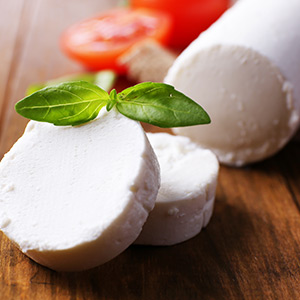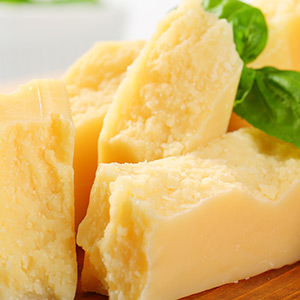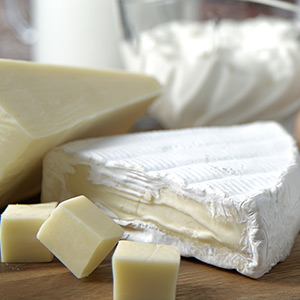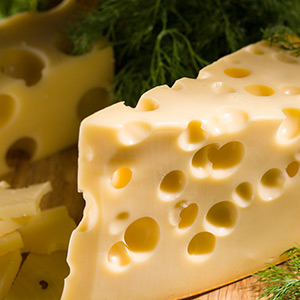Cheese Curds and Families

Learn all about the different classifications of cheeses.
Cheeses are first identified by their type of curd (fresh, soft, semi-hard, firm or hard), which in turn places them in different families. The family of cheese dictates how they should be eaten, cooked, served, stored, etc.
Fresh Curd Cheese
Fresh curd cheese is made using the simplest and oldest process. Made with whole, skimmed or cream-enriched milk, they are sold immediately and must be used soon after because of their very short shelf life.
Characteristics
Fresh curd cheese is white, rindless, and has a soft and creamy consistency. Moisture content is usually high, between 55% and 60%, and fat content varies between 20% and 33%.
Varieties
Our varieties of fresh curd cheese include Baker’s, Baron, garlic and herb Boursin, Brocciu, Damablanc, Delicrème, mascarpone, cottage, Quark , ricotta and many cream cheeses.
Purchasing tips
Look for a white curd, a neutral odour and a creamy texture. Avoid a product with a creamy yellow curd, an odour of ammonia or a granular or sticky texture.
How to best appreciate them
Fresh curd cheeses are very kid-friendly. They are spreadable, make great desserts, can be incorporated in pastries and are excellent in sauces and stuffings. For breakfast, lunch or dinner, as a snack with fresh cut vegetables or as dessert with fruit or jam, fresh curd cheeses are always a favourite.
Storage life
Fresh curd cheeses are best stored in their original packaging. Note the best before date. Because of their high moisture content, fresh curd cheeses don’t freeze very well. While freezing won’t affect the flavour of the cheese, it will alter its texture.

Hard Curd Cheese

Hard curd cheeses are in fact firm curd cheeses that have been aged over several months, sometimes years, until they lose over 70% of their moisture content. The result is a cheese that will keep for a very long period of time.
Characteristics
Covered with a dry, hard, dark yellow rind, these cheeses have a gold-coloured curd and a firm, crumbly texture that melts in your mouth. They exhibit wonderful aromas of bread, almond and apple, and have a rich hazelnut taste. Their rich flavour is robust, sometimes spicy and very salty.
Varieties
Bella Lodi, Grana Padano, Gruyère, Parmesan, Pecorino, Romano.
Purchasing tips
Look for a fine, shiny curd, a pronounced aroma and a very hard texture. Avoid a dried, granular or brownish curd.
How to best appreciate them
Nothing beats grated hard cheese over pasta, in a vegetable gratin, a sauce or a salad dressing. Mixed or served with other types of cheese, they will always stand out. They taste great on their own, paired with fresh grapes or black olives and red wine or Port.
Storage life
Hard curd cheeses can be stored for up to 6 months in an airtight container. In a plastic wrap or a perforated aluminium foil, they will keep for up to 2 months. To store them longer, change the wrapping regularly. Hard curd cheeses can be frozen if they are grated, shaved or cut in small pieces and packed in small portions (less than 500 grams). Like other cheeses, the texture can be altered slightly, but the flavour will remain unchanged. Make sure to refrigerate the cheese before freezing.
Soft Curd Cheeses
The soft-curd cheese family is divided into two categories: bloomy-rind cheeses and washed-rind cheeses.
Characteristics
Bloomy-Rind Soft-Curd cheeses: These have a creamy texture and a mushroom aroma; an unctuous and supple texture and a pale yellow curd.
Washed-Rind Soft-Curd Cheeses: They’re known for their delicate aroma of fruit, cream and hazelnut. They have a soft and unctuous consistency with an elastic curd.
Varieties
Bloomy-Rind Soft-Curd cheeses: Biquet, Boursault, Brie double crème, Brie de Vaudreuil, Camembert, Caprice des Dieux, Chèvrechon, Feta, Neufchâtel au lait cru, Paillot de chèvre, Saint-André and Saint-Honoré.
Washed-Rind Soft-Curd Cheeses: Empereur, Providence d’Oka, Saint-Damase and Sir Laurier d’Arthabaska.
How to best appreciate them
Served with fresh bread and fruit or a nice glass of red wine, soft-curd cheeses are a great way to end a meal. In fact, soft-curd cheeses are always a favourite at wine and cheese tastings. However, to bring out their full flavour and creamy texture, soft-curd cheeses should be served at room temperature, so always be sure to take them out of the refrigerator one hour before serving.
Purchasing Tips
The outside curd should be white, though some varieties also have golden grooves. The inside curd should be a creamy colour. Other signs of freshness include a mushroom flavour and an unctuous and creamy texture. Avoid a greyish-coloured rind, a pink or grey curd, an ammonia odour or a runny texture; all signs that the cheese is not fresh.
Storage life
These cheeses will keep for one to two weeks once package has been opened or three to four weeks if unopened. The original package can be replaced with waxed paper covered with foil.
If cut into, the cheese should be wrapped in waxed paper doubled in perforated aluminium foil and will keep for two to three weeks.

Firm-Curd Cheeses

Firm-curd cheeses form the largest cheese family. To give them their firmness, the curd is drained, then pressed to remove as much whey as possible. This type of cheese is not surface ripened. Instead, the ripening process begins in the center of the cheese and progresses outwards.
Characteristics
Firm-curd cheeses have a fat content between 20 and 32 per cent and a moisture content between 35 and 45 per cent. Except for Gouda, firm-curd cheeses are rindless, and have an ivory- to yellow-coloured curd and a tender and elastic texture. They are famous for their distinctive milk, cream and butter aromas. Depending on the variety of cheese and the ripening method used, the flavour can vary from fruity to nutty.
Varieties
Appenzeller, Brick, Caciocavallo, Cheddar, Chèvre Noir, Colby, Emmental, Farmers, Friulano, Curd Cheese, Gouda, Gruyère suisse, Jarlsberg, Le Moine, Miranda, Peau rouge, Provolone, Raclette, Canadian Swiss.
How to best appreciate them
Firm-curd cheeses can enhance any sandwich and add flavour to any salad. They are indispensable in quiches, omelettes and all gratins. They are excellent served on their own and make a healthy snack for kids—or grown-ups!
Purchasing tips
Look for a smooth and shiny curd, a fresh odour and a smooth texture. Avoid a sticky curd, mate colors of grey or pink, a sulphuric odour or a granular texture.
Storage
Store firm-curd cheeses in their original packaging, an airtight plastic container or wax paper doubled in aluminum foil. The best place to store cheese is in the vegetable crisper of your refrigerator. Grate firm-curd cheeses before freezing, so you don’t have to wait for them to thaw before using. Make sure to use a plastic freezer bag and refrigerate the cheese before freezing.
Semi-Firm Curd Cheese
This family offers the widest variety of cheeses and flavours. It is divided into three different categories: surface-ripened semi-hard washed-rind cheeses, non surface-ripened semi-firm curd and unripened semi-hard curd (also called string curd).
Characteristics
Surface-ripened semi-hard washed-rind cheeses: The rind is slightly sticky and varies from a coppery-pink to a coppery-brown colour. The curd has a soft and mellow texture and its colour varies from ivory to yellow.
Non surface-ripened semi-firm curd: Most of these cheeses are rindless, but some varieties are covered with a protective plastic film. The texture of these cheeses offer a slight resistance when you bite into them and their colour varies from ivory to yellow.
Unripened semi-hard curd (also called string curd): These cheeses are rindless and have a nice, shiny ivory colour. Some aged or smoked varieties are more full-bodied.
Varieties
Surface-ripened semi-hard washed-rind cheeses: Clos St-Ambroise, Douanier, Mamirolle, Oka, Cantonnier, Migneron de Charlevoix, Tomme, Vacherin, Chaume, Mouton Noir, Reblochon, Saint-Morgon.
Non surface-ripened semi-firm curd: Gruyère, Monterey Jack, Buttiri, Havarti, Munster, Casata, Mont Saint-Benoît, Saint-Paulin, Edam, Gouda.
Unripened semi-hard curd (also called string curd): Bocconcini, Mozzarella, Scarmoza, Fior di Latte, Trecce, Caciotta.
Purchasing Tips
Surface-ripened semi-hard washed-rind cheeses: Look for a coppery-pink to coppery-brown rind, a delicate aroma and a slightly sticky texture. Avoid a product with a dry and crumbly texture.
Non surface-ripened semi-firm curd: Look for a bright, cream-coloured curd, a supple and slightly elastic texture. Avoid a cheese with a bitter taste and a dry or crumbly texture.
Unripened semi-hard curd (also called string curd): Look for a shiny, cream-coloured curd and a supple, slightly elastic texture. Avoid cheeses with a dry and crumbly texture.
Storage life
In the original, unopened package, semi-firm curd cheese will keep for two to three months. Once opened, wrap in waxed-paper and cover with foil. Will keep for up to three weeks.
















